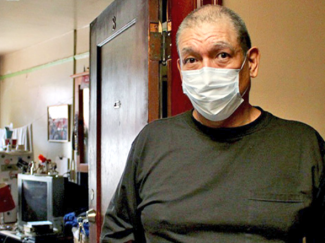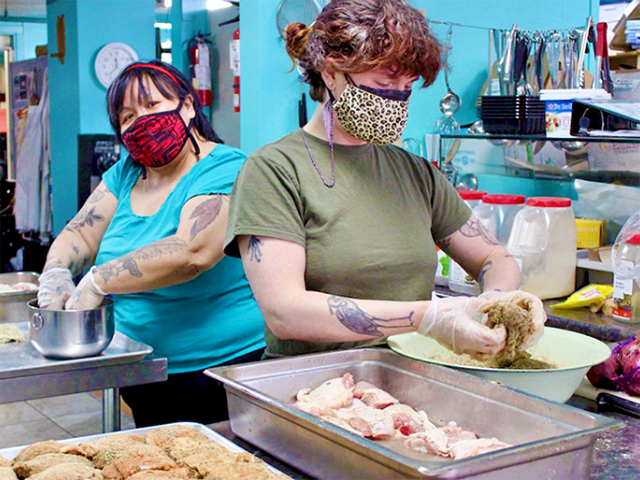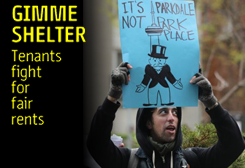GOOD NEIGHBOURS
Tenants turn their COVID care into a collective effort

SRO tenant Kevin
THE TABLE IN THE LOBBY SAYS IT ALL. The tenants in this building look out for each other. Just as the SRO Collaborative worked to be sure they could.
The small table is piled with disposable masks, bottles of hand sanitizer and a paper bag holding hand soap. There are also a couple of cans of pork and beans and a jar of peanut butter. All regularly replenished. All free for the taking. All to help keep residents protected during the COVID-19 pandemic.
SRO Collaborative
It’s part of an effort that’s been going on for over a year in Vancouver SROs (privately-owned single-room occupancy hotels) where the SRO Collaborative worked with tenants to organize themselves to help themselves.
The SRO Collaborative was established to organize SRO tenants in Vancouver’s Downtown Eastside and Chinatown. SROs are typically small single rooms about 10×10 feet that don’t have their own kitchen or bathroom. Twenty tenants on a floor will often share one bathroom—which isn’t usually stocked with hand soap.
SROs are the housing of last resort for many people in Vancouver.
Tenants for tenants
The SRO Collaborative organizing strategy is to identify residents who are already playing a leadership role in the buildings, and then work with them to support tenants with supplies and other resources. The group is now working with tenant leaders in 52 buildings.
“It’s like, who’s at the village well? says Wendy Pedersen, a tenant organizer with the SRO Collaborative. “Who’s talking [to] everybody all day long, who has their door propped open?”
Kevin is one of those natural leaders. He lives in one of the nicer buildings. But he’s currently sleeping on a yoga mat because of a previous bed bug infestation. His neighbour, Dave, says he moved into the building after getting injured on the job and being homeless for several months.
“I was looking for a place anywhere in the Lower Mainland, and do you think I could find a one-bedroom apartment anywhere for $1,200?” Dave said.
Checking on your neighbours
Kevin regularly knocks on his neighbour’s door to ask how he’s doing. The elderly man has trouble going up and down stairs and doesn’t leave his room very often.
“Because we don’t have elevators in that building, every Thursday I take the food they deliver up to him.”
Richard Schwab first got involved with the SRO Collaborative when his building, a 29-unit SRO in Strathcona, was sold to a new owner. The collaborative helped tenants regain access to the house telephone.
Building leaders who worked with the SRO Collaborative also worked to keep their neighbours informed of where to go to get tested and vaccinated.
Schwab and Kevin both said they weren’t aware of any COVID-19 cases in their buildings over the entire course of the pandemic.
“We’re taking a really community-based, tenant-centred approach,” Pedersen said. “And it’s very autonomous. So we’re just there for the tenants, we’re not there to property manage their buildings, or to evict them.”

Tenants work on food prep for other tenants
Tackling hunger
Hunger is another problem for most SRO tenants. The collaborative stocks common areas in buildings with boxes of macaroni and canned goods. The SRO Collaborative also provides meals five times a week to SRO residents, as well as coupons for meals at two local restaurants.
Sonya Jackson cooks for 100 SRO residents once a week at the Downtown Eastside Neighbourhood House. She’s paid for her work, but she also volunteers a couple hours of her time to plan and prep meals.
The SRO Collaborative runs its programs through a mix of donations and grants and pays building residents for the time they spend delivering supplies or training their neighbours on how to reverse overdoses.
“Working for restaurants is one thing,” she says “but when you’re putting food out there and knowing where it is going, it means a lot more than what I was doing before.”
- 30 -













Add new comment